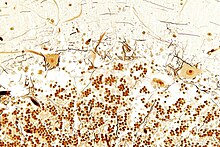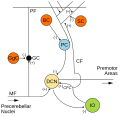Basket cell
| Basket cell | |
|---|---|
Purkinje cells | |
| Identifiers | |
| NeuroLex ID | nifext_160 |
| Anatomical terms of neuroanatomy] | |
Basket cells are inhibitory GABAergic interneurons of the brain, found throughout different regions of the cortex and cerebellum.[1]
Anatomy and physiology
Basket cells are multipolar
Basket cells can be found throughout the brain, in among other the cortex, hippocampus, amygdala, basal ganglia, and the cerebellum.[citation needed]
Cortex
In the cortex, basket cells have sparsely branched axons giving off small pericellular, basket-shaped elaborations at several intervals along their length. Basket cells make up 5-10% of total neurons in the cortex.[5] There are three types of basket cells in the cortex, the small, large and nest type:[6] The axon of a small basket cell arborizes in the vicinity of that same cell's dendritic range, this axon is short. In contrast, large basket cells innervate somata in different cortical columns due to a long axon.[5] The nest basket cells are an intermediate form of the small and large cells, their axons are confined mainly to the same cortical layer as their somata. Nest basket cells have "radiating axonal collaterals" between that of large and small basket cells. They are included as basket cells because they are interneurons that perform axo-somatic synapses.[5]
Hippocampus
Hippocampal basket cells target
Cerebellum

In the cerebellum, the multipolar basket cells have branching
Additional images
-
Microcircuitry of the cerebellum.inhibitory synapsesby (-). Basket cell labeled BC.
-
Cerebellum
External links
- Cell Centered Database - Cerebellar basket cell
- NIF Search - Basket Cell[permanent dead link] via the Neuroscience Information Framework
See also
List of distinct cell types in the adult human body
References
- ISBN 978-0-306-41544-9.
- ^ "Stahl's Essential Pharmacology".[unreliable medical source?]
- ^ Jones, EG; Hendry, SHC (1984). "Basket cells". In Peters, A; Jones, EG (eds.). Cerebral cortex: cellular components of the cerebral cortex. New York: Plenum Press. pp. 309–34.
- PMID 7477292.
- ^ PMID 11884355.
- ^ Fox, Kevin. Barrel Cortex. Cambridge University Press. pp. 55–6.
- PMID 15288889.
- ^ Bryne, John. "Feedback/recurrent inhibition: Feedback inhibition in microcircuits". Neuroscience Online. University of Texas Health Center. Archived from the original on 2013-12-03. Retrieved 2013-07-27.
- PMID 9437016.
- PMID 10517801.


